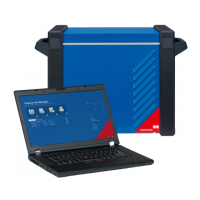CIBANO 500 PTM User Manual
198 OMICRON
3. In the Assessment area, configure the assessment.
► Click Edit configuration or click in one of the tables to open the Assessment configuration
dialog box, and then edit the assessment limits.
► Select the Automatic assessment check box to enable the automatic assessment.
Note: For the assessment limit definitions, see 15.3 "Assessment limits" on page 107.
4. By using the Open breaker, Close breaker and Supply motor buttons in the Measurements area
of Primary Test Manager (see 11.1 "Test control commands" on page 85) you can check whether all
cables are correctly connected and bring the circuit breaker to the proper state. For example, to test
a C sequence, the circuit breaker must be open and the spring charged.
CO With this sequence, a tripping operation after the circuit breaker has been
closed under a fault condition (trip-free) or the verification of the correct
operation of the anti-pumping system is simulated.
To test the trip-free time the circuit breaker must be in the open position
before the test is started. The circuit breaker is closed and then during the
close operation is still in progress an open command is sent. The circuit
breaker then opens as fast as possible.
To test the anti-pumping function of the circuit breaker, the circuit breaker
must be in closed position before the test is started. For this test the open
time is set shorter (typically 200 ms) than the closing time (typically 400 ms).
Ensure that the end time is increased so that the test sequence covers the
whole close command duration (typically at least 190 ms). When the close
command is sent the circuit breaker is already closed which initiates the
anti-pumping function. Then an open command is sent and the circuit
breaker trips. The closing command is still on when the open command
ends, but the circuit breaker should not "pump", so that it should not close
again.
O-CO With this sequence, a reclose sequence (OC) under a fault condition is
simulated. If the fault is not released, the circuit breaker must open (O)
immediately and remain in this position.
Initially, the circuit breaker must be in the closed position. The sequence
begins with an open command, after a dead time the close and open
commands (CO) must be applied at the same time (delay time typically
300 ms).
CO-CO Some circuit breakers have a different specification for the pause time
between CO and CO for CO-CO and O-CO-CO sequences. Therefore both
sequences are available for testing. The time between the two CO
subsequences shall be set according to the technical data of the circuit
breaker (typically 15000 ms).
O-CO-CO Some circuit breakers have a different specification for the pause time
between CO and CO for CO-CO and O-CO-CO sequences. Therefore both
sequences are available for testing. The time between the two CO
subsequences shall be set according to the technical data of the circuit
breaker (typically 15000 ms).
Table 17-51: Dynamic Contact Resistance test sequences (continued)
Sequence Action

